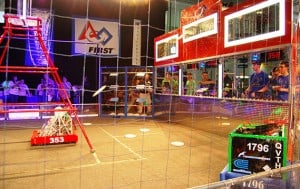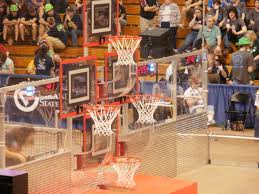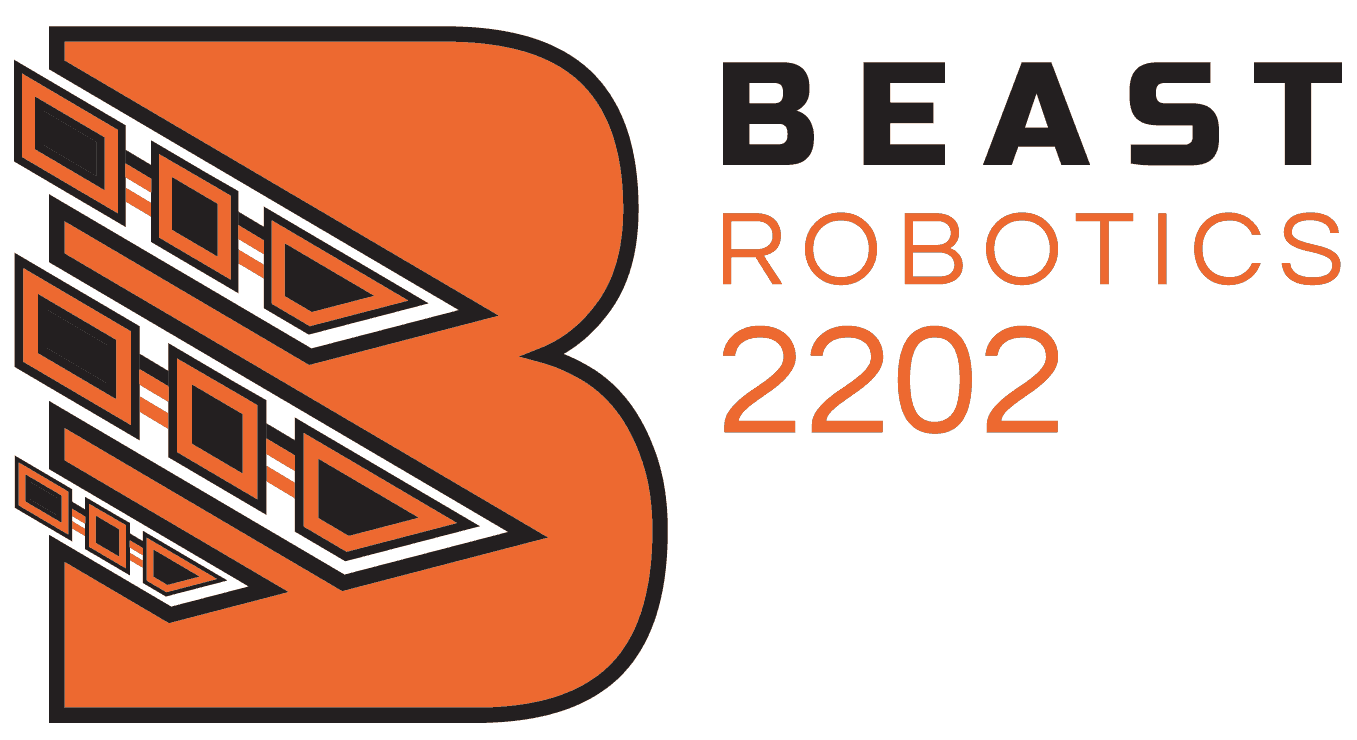2014 – AERIAL ASSIST
2013 – ULTIMATE ASCENT
 ULTIMATE ASCENT is played by two competing alliances on a flat, 27 x 54 foot field. Each Alliance consists of three robots, and they compete to score as many discs into their goals as they can during a two (2)-minute and fifteen (15)-second match. The higher the goal in which the disc is scored, the more points the Alliance receives. The match begins with a fifteen (15)-second Autonomous Period in which robots operate independently of driver inputs. Discs scored during this period are worth additional points. For the remainder of the match, drivers control robots and try to maximize their alliance score by scoring as many goals as possible. The match ends with robots attempting to climb up pyramids located near the middle of the field. Each robot earns points based on how high it climbs.
ULTIMATE ASCENT is played by two competing alliances on a flat, 27 x 54 foot field. Each Alliance consists of three robots, and they compete to score as many discs into their goals as they can during a two (2)-minute and fifteen (15)-second match. The higher the goal in which the disc is scored, the more points the Alliance receives. The match begins with a fifteen (15)-second Autonomous Period in which robots operate independently of driver inputs. Discs scored during this period are worth additional points. For the remainder of the match, drivers control robots and try to maximize their alliance score by scoring as many goals as possible. The match ends with robots attempting to climb up pyramids located near the middle of the field. Each robot earns points based on how high it climbs.
2012 – REBOUND RUMBLE
 Rebound Rumble℠ is played by two competing Alliances on a flat, 27 x 54 foot field. Each Alliance consists of three robots. They compete to score as many basketballs into their hoops as they can during a 2 minute and 15 second match. The higher the hoop in which the basketball is scored, the more points the Alliance receives. The match begins with a 15-second Hybrid Period in which robots may be controlled using a Microsoft Kinect. Baskets scored during this period are worth extra points. The match ends with robots attempting to balance on bridges located at the middle of the field. In Qualification Matches, a robot from each Alliance will also try to balance on the white Coopertition™ bridge to score additional ranking points for each Alliance.
Rebound Rumble℠ is played by two competing Alliances on a flat, 27 x 54 foot field. Each Alliance consists of three robots. They compete to score as many basketballs into their hoops as they can during a 2 minute and 15 second match. The higher the hoop in which the basketball is scored, the more points the Alliance receives. The match begins with a 15-second Hybrid Period in which robots may be controlled using a Microsoft Kinect. Baskets scored during this period are worth extra points. The match ends with robots attempting to balance on bridges located at the middle of the field. In Qualification Matches, a robot from each Alliance will also try to balance on the white Coopertition™ bridge to score additional ranking points for each Alliance.
2011 – LOGO MOTION™
 In the 2011 game, LOGO MOTION™, two alliances of three teams compete on a 27-by-54-foot field with poles, attempting to earn points by hanging as many triangle, circle, and square logo pieces as possible. Bonus points are earned for each robot that can hang and assemble logo pieces to form the FIRST logo. Robots can also deploy Mini-Bots to climb vertical poles for a chance to earn additional points.
In the 2011 game, LOGO MOTION™, two alliances of three teams compete on a 27-by-54-foot field with poles, attempting to earn points by hanging as many triangle, circle, and square logo pieces as possible. Bonus points are earned for each robot that can hang and assemble logo pieces to form the FIRST logo. Robots can also deploy Mini-Bots to climb vertical poles for a chance to earn additional points.
2010 – BREAKAWAY®
 In the 2010 game, BREAKAWAY®, two alliances of three teams compete on a 27-by-54-foot field with bumps, attempting to earn points by collecting soccer balls in goals. Additional bonus points are earned for each robot suspended in air and not touching the field at the end of the match.
In the 2010 game, BREAKAWAY®, two alliances of three teams compete on a 27-by-54-foot field with bumps, attempting to earn points by collecting soccer balls in goals. Additional bonus points are earned for each robot suspended in air and not touching the field at the end of the match.
2009 – LUNACY®
 In the 2009 game, LUNACY®, robots are designed to pick up 9″ game balls and score them in trailers hitched to their opponents‟ robots for points during a 2 minute and 15 second match. Additional points are awarded for scoring a special game ball, the Super Cell, in the opponents’ trailers during the last 20 seconds of the match. “LUNACY” is played on a low-friction
In the 2009 game, LUNACY®, robots are designed to pick up 9″ game balls and score them in trailers hitched to their opponents‟ robots for points during a 2 minute and 15 second match. Additional points are awarded for scoring a special game ball, the Super Cell, in the opponents’ trailers during the last 20 seconds of the match. “LUNACY” is played on a low-frictionfloor, which means teams must contend with the laws of physics.
2008 – Overdrive
 In the 2008 game, “FIRST Overdrive,” students’ robots are designed to race around a track knocking down 40″ inflated Trackballs and moving them around the track, passing them either over or under a 6’6″ overpass. Extra points are scored by robots positioning the Trackballs back on the overpass before the end of the 2 minute and 15 second match.
In the 2008 game, “FIRST Overdrive,” students’ robots are designed to race around a track knocking down 40″ inflated Trackballs and moving them around the track, passing them either over or under a 6’6″ overpass. Extra points are scored by robots positioning the Trackballs back on the overpass before the end of the 2 minute and 15 second match.
2007 – Rack ‘N’ Roll
In the 2007 game, “Rack „N‟  Roll,” students‟ robots are designed to hang inflated colored tubes on pegs configured in rows and columns on a 10-foot high center “rack” structure. Extra points are scored by robots being in their home zone and lifted more than 4” off the floor by another robot before the end of the 2 minute and 15 second match.
Roll,” students‟ robots are designed to hang inflated colored tubes on pegs configured in rows and columns on a 10-foot high center “rack” structure. Extra points are scored by robots being in their home zone and lifted more than 4” off the floor by another robot before the end of the 2 minute and 15 second match.
